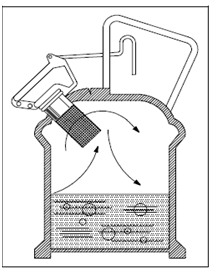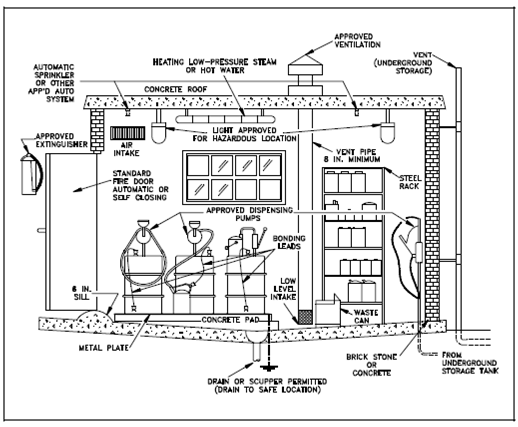Storage:
Class I and Class II liquids should not be remain or stored within a building except in approved containers, as described in Figure, inside either a storage cabinet or a storage room which does not have an opening which communicates along with the public portion of the building. A spring-loaded cover is designed to open in sequence to relieve internal vapor pressure. Quantities stored within such locations should be limited. They should not be stored so as to limit use of exits, stairways, or areas generally used for the safe egress of people. Neither should they be stored close to stoves or heated pipes, nor exposed to the rays of the sun or other sources of heat.

Figure: Storage Container With Spring-loaded Cover
Losses through evaporation of liquid stored within safety cans at ordinary temperatures are negligible. Storage of combustible and flammable liquids in open containers should not be allowed. Approved containers for flammable liquids should be closed after every use and while null. Warning labels should be erased from flammable liquid containers while empty (vapor free). A Bulk Class I liquids should be stored within an underground (buried) tank or outside a building. No outlet from the tank should be within a building unless it terminates within a special room, as described in below figure.

Figure: A Flammable Liquids Mixing and Storage Room
To transport vehicles used on plant property flammable and combustible liquids within sealed containers that should be designed to minimize damage to the containers.
While employees are filling tanks and other containers that should be sure to permit sufficient vapor space (outage) above the liquid level in sequence to allow expansion of the liquid along with changing temperatures. For instance, gasoline expands at the rate of about one percent for each 14ºF rise in temperature. Compartment is recommended or Outage space for gasoline of two percent of the capacity of the tank, and permanent high-level markings should be installed.
Storage tanks should be given along with vents. Vent pipes of underground tanks storing Class I flammable liquids that should terminate from outside buildings, higher than the fill pipe opening and not less than 12 feet above the adjacent ground level. That should discharge vertically upward, and be located so in which flammable vapors cannot enter building be trapped or openings under eaves or another obstructions. Vent pipes from underground tanks storing Class II or Class III liquids should terminate outside buildings and higher than the fill pipe opening. Vent outlets should be above general snow level.